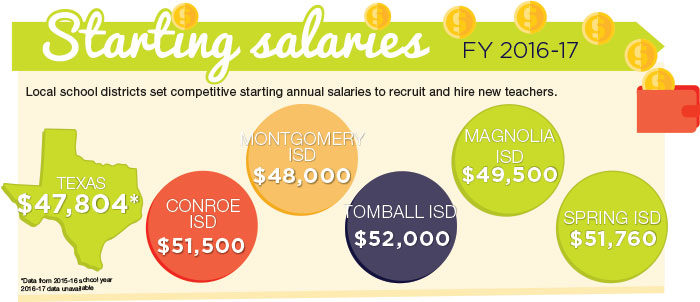 While school districts grapple with the effects of a statewide teacher shortage, Conroe, Tomball and Magnolia ISDs are keeping positions filled by increasing teacher salaries and prioritizing retention.
While school districts grapple with the effects of a statewide teacher shortage, Conroe, Tomball and Magnolia ISDs are keeping positions filled by increasing teacher salaries and prioritizing retention.
Nationally, 500,000 teachers exit the industry each year, collectively costing school districts as much as $2 billion annually in recruiting and training teacher replacements, according to a 2014 report from the Alliance for Excellent Education, a national education policy and advocacy organization. In Texas alone, the teacher turnover costs school districts $235 million annually, the report stated.
CISD, MISD and TISD lost 13.1 percent, 15.8 percent and 10.8 percent of their teachers, respectively, between the 2012-13 and 2013-14 school years, according to the Texas Education Agency’s most recent data.
Although district officials downplayed the effects of the statewide shortage in local schools, the three school districts are boosting salaries and enhancing workplace environments to remain competitive, avoid turnover and keep pace with enrollment growth.
“I think we are attractive enough for teachers to want to come and live in our district,” MISD Chief Financial Officer Erich Morris said. “There’s no indicator that the teacher shortage in any capacity is really causing us any issues at
this point.”
Tomball ISD Superintendent Huey Kinchen also said TISD has yet to see a significant effect from the
statewide trend.
“We have not experienced a teacher shortage in Tomball ISD,” Kinchen said. “However, retaining quality teachers is very important.”
 Teacher demand
Teacher demand
According to the U.S. Department of Education, Texas was federally recognized for teacher shortages in several subject areas for the 2014-15 and 2015-16 school years. These include: English as a second language, career and technical education, computer science, mathematics, science and special education on the elementary and secondary levels.
“These content areas are in demand across the nation as there are fewer candidates graduating from universities,” said Kathy Sharples, CISD director of human resources.
Gary Godsey, executive director of Association of Texas Professional Educators, said thousands of new students enroll in Texas public schools each year, requiring districts to hire thousands of teachers across the state.
“Every year when 80,000 new kids enter the [Texas public education] system, that creates thousands of jobs that need to be filled just to educate those 80,000,” Godsey said. “That’s about the size of a Fort Worth school district coming on board every single year in Texas.”
Since the 2010-11 academic year, CISD has added 7,069 students, according to the Population and Survey Analysts demographics firm. To address the growth, CISD added 122 new teaching positions for 2016-17.
“With an enrollment growth of approximately 1,500 students per year, we add the teachers and support staff as necessary to meet the needs of our learners,” Sharples said.
Although new teachers are coming on board, Sharples said relocation and retirement challenge teacher retention.
“Our analysis of teacher retention shows that relocation is one of the top reasons for leaving CISD,” Sharples said.
Since the 2010-11 academic year, TISD has added 3,451 students, according to PASA. Meanwhile, MISD has added 993 students in the last five years. To keep up with increased enrollment, MISD added 15 classroom-related positions for 2016-17. MISD has a total of about 150 new teachers starting in 2016-17.
TISD added 63 new teaching positions for 2016-17 to staff its new Creekside Park Junior High School, which opened in August. A total of 135 new teachers joined the district this academic year.
“When you’re used to being in a district that has student growth and economic growth, you have to plan for it,” Morris said.
MISD Director of Communications Denise Meyers said although recruiting teachers for some subject areas—such as science, technology, engineering and math courses—is harder than others, the district has not struggled to fill vacant teaching positions.
“We have the teachers that we need. I think the challenge is finding the specialty areas and that’s always been a challenge—like those STEM classes, the high-level chemistry classes, bilingual teachers,” she said. “Those are always a challenge [to find].”
 Increasing salaries
Increasing salaries
To address demand for new teachers, school districts are boosting salaries to remain competitive and are looking beyond Texas for teachers.
Recruiting teachers from out of state is a growing trend throughout Texas. Between 2011 and 2015, the number of out-of-state teachers receiving Texas certification increased from 2,370 to 3,875, according to
the TEA. Although local districts are not spending significant funds on out-of-state recruitment efforts, they continue to increase salaries to stay competitive with other districts.
CISD offers first-year teachers $51,500 in fiscal year 2016-17, compared with $51,000 last fiscal year. The average starting annual salary for a teacher in Texas schools with more than 10,000 students in FY 2015-16 was $47,804, according to the Texas Association of School Boards. CISD increased teacher salaries overall by about 3 percent for FY 2016-17.
CISD also provides a health and wellness center for its employees.
“That’s a huge tool both in retaining and bringing in teacher candidates,” Sharples said.
Morris said teacher recruitment costs MISD between $5,000-$10,000 each year. He estimates 70 percent of MISD teachers come from within the state.
“We don’t do near as much [traveling to recruit teachers] as other districts do,” he said.
TISD and MISD increased salaries for returning teachers by 2 and 4 percent, respectively, for the 2016-17 school year.
In TISD, the starting salary for a TISD teacher has grown from $51,250 in 2015-16 to $52,000 for FY 2016-17. A first-year teacher at MISD will receive $49,500 in FY 2016-17, compared with $48,000 last year.
In an effort to retain teachers, Kinchen said TISD not only focuses on offering competitive salaries but also strives to shows its teachers they are valued.
“We offer teachers continued support through professional development, and we have increased technology for teachers to use in the classroom,” Kinchen said.
Morris said MISD strives to offer teachers a salary competitive to the surrounding districts to encourage teacher retention as well as increase supplemental income, such as benefits and extracurricular stipends.
Although it is higher than the statewide average salary, MISD’s starting salary is lower than that of nearby districts, such as TISD, Cy-Fair ISD and Spring ISD, all of which have higher student enrollment.
Morris said one way to solve the teacher shortage is to again value the teaching profession, encouraging students to become teachers.
“There’s a need for a mindset change at our federal and state government levels in terms of getting back to the era of valuing our teachers and the teaching profession—just as we do within our district,” Morris said.




